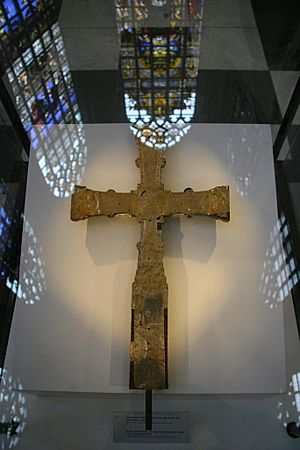Brussels Cross facts for kids
The Brussels Cross (also called the Drahmal Cross) is a very old Christian cross. It was made in England around the early 11th century. This special cross is also a reliquary, which means it holds a holy relic inside. Today, you can find it in the treasury of the St. Michael and St. Gudula Cathedral in Brussels, Belgium. It has cool pictures and words carved into it in Old English, which is an early form of the English language.
Contents
What is the Brussels Cross?
The Brussels Cross has been damaged over time. It used to have jewels on its front, but they are now missing. The cross is made of wood and covered with a silver plate. This silver plate has small, round pictures carved into it. At the ends of the cross's arms, you can see symbols for the four Gospel writers. In the middle, there is a picture of the Agnus Dei, which means 'Lamb of God'.
The Special Messages on the Cross
The artist who made the cross carved his name across its arms. It says in large Latin letters: + Drahmal me worhte. This means 'Drahmal made me'.
Around the edges of the cross, there is another message. It is written in Old English and says: + Rod is min nama; geo ic ricne Cyning bær byfigynde, blod bestemed. This translates to: 'Rood (Cross) is my name. Trembling once, I bore a powerful king, made wet with blood'. These lines are very similar to parts of an old English poem called 'The Dream of the Rood'.
After this, there is a dedication. It explains why the cross was made: þas rod het Æþmær wyrican and Aðelwold hys beroþo[r] Criste to lofe for Ælfrices saule hyra beroþor. This means 'Æthlmær and Athelwold, his brother, ordered this cross to be made to praise Christ for the soul of Ælfric, their brother'.
How the Words are Written
The Anglo-Saxon words are on a silver strip around the cross's edges. They are written using Roman letters, not runes. It's a mix of big and small letters, like Latin writing. Some letters are joined together, like 'NE' in ricne.
Experts believe the language used points to the cross being made in the late 10th century or a bit later.
Where Did the Cross Come From?
People first learned about the Brussels Cross and its special words in modern times in 1891. For a long time, it was believed to hold the biggest pieces of the True Cross. The True Cross is thought to be the cross Jesus was crucified on.
The cross has been kept at the Cathedral of SS. Michel and Gudule since the mid-1600s. It measures about 46.5 by 28 centimeters (18.3 by 11 inches). The front of the cross was once covered with a gold plate and jewels. These were probably taken by French soldiers in 1793. The back is still covered with silver. It shows the symbols of the four Gospel writers and the Agnus Dei in the center.
The craftsman's name, Drahmal, is probably Norse and from northern England. We don't know much more about him. Based on the language and the style of the pictures, the cross was most likely made at the beginning of the 11th century. The pictures are in a simple version of the early "Winchester style" of art.
The Three Brothers
The Brussels Cross was made in England. The three brothers mentioned in the inscription – Ælfric, Æthelmær, and Æthelwold – have never been fully identified. The language used in the inscription is mostly late West-Saxon, which was a common form of Old English.
Some scholars have tried to link these brothers to people from Worcester around the year 1007. Others think Æthelmær might be a famous supporter of Ælfric of Eynsham, who started a monastery in 1005. However, these ideas are hard to prove.
The Relic's Journey
It's also possible that the holy relic inside the cross is the same "Wood of the Lord" that Pope Marinus I sent to King Alfred in 883 or 885.
A Belgian scholar named Simone D’Ardenne has a very likely idea. She believes the relic is indeed Alfred’s "Wood of the Lord." She thinks it stayed with the West-Saxon royal family until the late 900s. Then, new owners put it inside the current cross and gave it to Westminster Abbey. Later, it probably ended up in the Netherlands. This might have happened during the time of King Stephen (1135–1154), when many soldiers from Flanders were in England.


